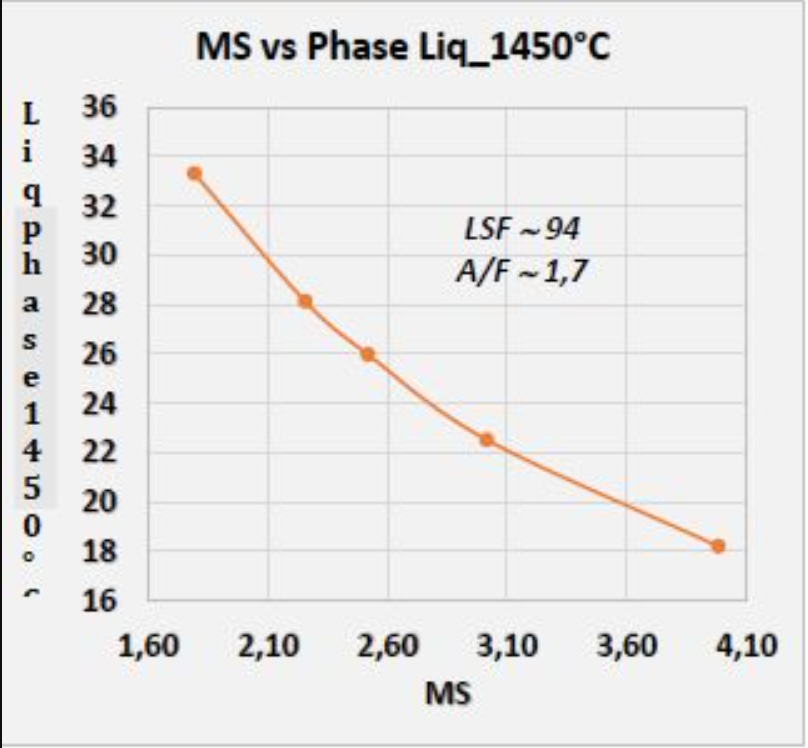Contents
The Relationship Between Modulus of Silica (MS) and Liquid Phase in Cement Production

TO Download this post and all the books and excel sheets and my personal notes and presentations I collected about cement industry in the last 30 years click the below paypal link
In cement production, the formation of a liquid phase during the clinkering process is a critical factor that influences the burnability and quality of the final clinker. Understanding the relationship between the Modulus of Silica (MS) and the liquid phase at a fixed Lime Saturation Factor (LSF) and Alumina to Ferric Oxide Ratio (AF) is essential for optimizing cement manufacturing processes.
Understanding the Modulus of Silica (MS) and Liquid Phase Formation
The Modulus of Silica (MS) is a key parameter in cement chemistry that represents the ratio of silicon dioxide (SiO2) to the sum of alumina (Al2O3) and ferric oxide (Fe2O3) in the raw mix. It is mathematically expressed as:
MS=SiO2Al2O3+Fe2O3MS = \frac{SiO_2}{Al_2O_3 + Fe_2O_3}
In the clinkering process, the formation of a liquid phase is vital as it allows the solid components to react and form the desired clinker minerals, such as alite (C3S) and belite (C2S). The temperature at which this liquid phase forms is typically around 1450°C.
Graphical Analysis: The Impact of MS on Liquid Phase Formation at 1450°C
In the presented graph, we observe the impact of varying the Modulus of Silica (MS) on the liquid phase formation at a constant temperature of 1450°C, while keeping the Lime Saturation Factor (LSF) and Alumina to Ferric Oxide Ratio (AF) constant. The following key observations can be made:
- Decreasing Liquid Phase Formation with Increasing MS: As the Modulus of Silica increases, the graph indicates a decrease in the ability to form a liquid phase at 1450°C. This suggests that higher silica content in the mix reduces the ease with which the liquid phase forms.
- Implications for Clinker Formation: The reduction in the liquid phase at higher MS values implies that clinker formation becomes more difficult. Since the liquid phase is crucial for the formation of C3S and C2S, higher MS could lead to a lower burnability of the raw mix, potentially resulting in a clinker with lower reactivity and strength.
- Optimization of Burnability and Clinker Quality: The specified LSF and A/F values in this analysis suggest a focus on producing standard Portland cement. In such a scenario, controlling the liquid phase is essential for achieving optimal burnability and ensuring the quality of the final clinker product.
Practical Considerations for Cement Manufacturers
For cement manufacturers, understanding the relationship between MS and liquid phase formation is crucial for optimizing the raw mix design. Higher MS values may necessitate adjustments in the raw material proportions or burning conditions to ensure adequate liquid phase formation and, consequently, high-quality clinker.
Strategies for Optimization:
- Raw Mix Adjustments: If the MS is too high, consider reducing the silica content or increasing the alumina and ferric oxide content to enhance liquid phase formation.
- Temperature Control: Ensure that the kiln operates at optimal temperatures to compensate for reduced liquid phase formation at higher MS values.
- Quality Monitoring: Regularly monitor clinker quality and adjust the raw mix composition as needed to maintain consistent product standards.
Conclusion
The relationship between the Modulus of Silica (MS) and liquid phase formation is a key factor in cement production. As MS increases, the ability to form a liquid phase at 1450°C decreases, which can impact clinker quality and burnability. By carefully managing raw mix composition and maintaining optimal kiln conditions, cement producers can optimize the clinkering process and produce high-quality cement.
Sources and References
- “Cement Chemistry” by H.F.W. Taylor – This book provides an in-depth understanding of the chemistry involved in cement production, including the role of the Modulus of Silica (MS). Available at: https://www.amazon.com/Cement-Chemistry-H-F-W-Taylor/dp/0727725920
- “The Rotary Cement Kiln” by Kurt E. Peray – This reference discusses the practical aspects of kiln operation and the importance of liquid phase formation in clinker production. Available at: https://www.amazon.com/Rotary-Cement-Kiln-Kurt-Peray/dp/0820603678
- “Advanced Materials and Techniques for Reinforced Concrete Structures” by Mohamed A. El-Reedy – This book touches on the importance of raw mix composition in cement production. Available at: https://www.amazon.com/Advanced-Techniques-Reinforced-Concrete-Structures/dp/1439816008
- “Industrial Chemistry of Cement” by F.M. Lea – A classic reference that provides insights into the chemical processes of cement manufacturing, including the formation of the liquid phase. Available at: https://www.amazon.com/Leas-Chemistry-Cement-Concrete-F-Lea/dp/0750662565
- “Kiln Operation in Cement Manufacturing” – An industry report detailing the relationship between raw mix composition and kiln performance. Available at: https://www.worldcement.com/kiln-operation-in-cement
These references provide a solid foundation for understanding the complexities of raw mix design and its impact on cement production, helping industry professionals optimize their processes for better efficiency and product quality.
TO Download this post and all the books and excel sheets and my personal notes and presentations I collected about cement industry in the last 30 years click the below paypal link
